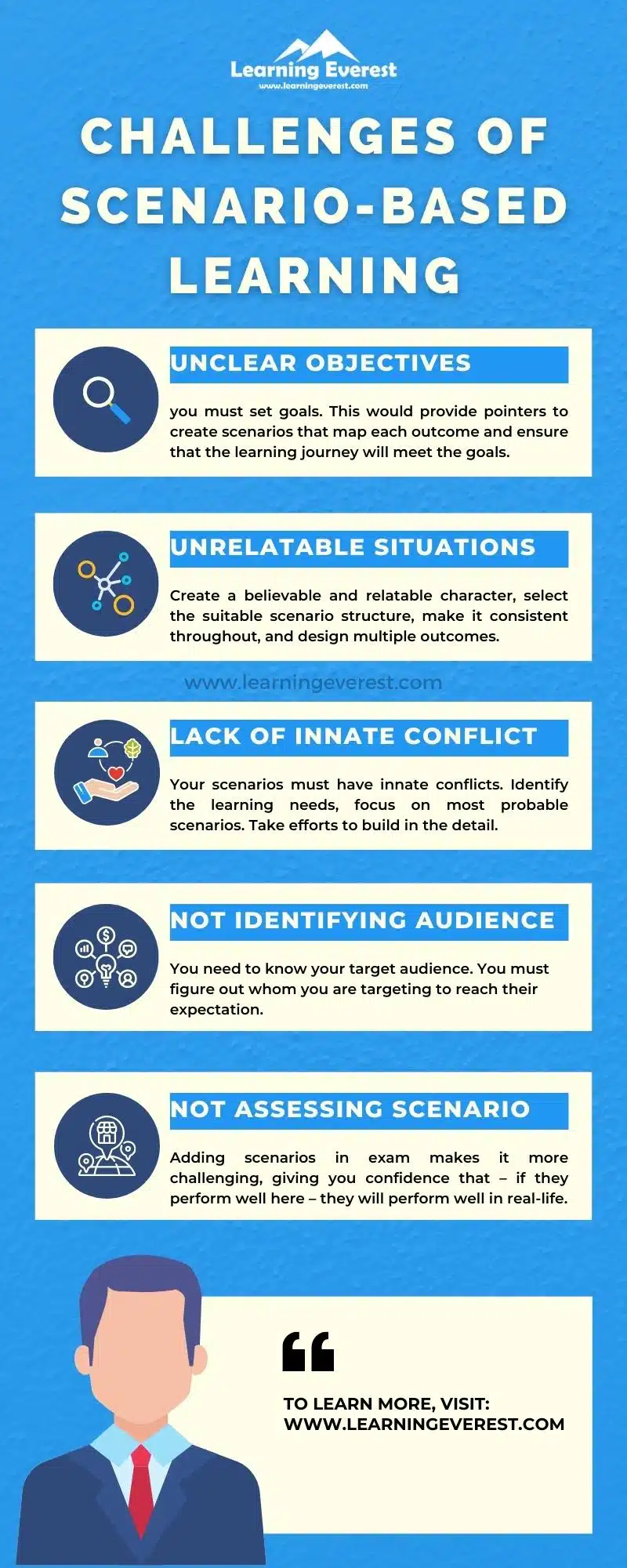What do you think is scenario-based learning and what are the challenges of scenario-based learning? A scenario is a story with characters and real-life conflicts and situations. A scenario-based learning program offers the learners a scenario or a situation and is then asked how to move forward in that given scenario to generate the learner’s response. A scenario works just like those stories you read. Instead of teaching through instructions, a scenario helps learners visualize situations involving characters playing specific roles. Here the learner gets to make certain decisions based on the situation, leading to positive or negative consequences.
A scenario-based learning environment eliminates the lack of personal one-on-one engagement with instructors by providing an interactive environment for active learning. This type of learning aims to identify a solution or response to a real-life issue. Through scenario-based learning, it is possible to provide compliance training, soft skills training, professional skills training, leadership training, etc.
This blog will discuss a few challenges you can face while developing scenario-based learning!
Challenges of scenario-based learning
Creating scenario-based learning is a challenging job. Because you need to place it properly so people can find it helpful, ensure you have avoided the following to create effective scenario-based learning for your learners.
Not identifying the target audience
First and foremost, before developing a learning module, you need to know your target audience. You must figure out whom you are targeting to reach their expectation. So, find out who the learners are. Also, you need to know the following facts: Are they beginners just starting their careers? Or do they have little knowledge about the industry? What do your learners expect from the training? Will they take your training course to learn, or do they want to refresh their skills? What are their professional goals and aspirations?
Unclear objectives
After finding out your target audience, plan what to offer them. And what benefits will they get after finishing your course? That means you must set goals for each of your courses. This would provide pointers to create scenarios that map each outcome and ensure that the training journey will meet the expected goals. Remember instructional design basics when creating a scenario. Ask: “Where do the learners need to learn at the end of the course?” Understand what your organization needs to accomplish with the blend, and identify how the scenario contributes to that goal.
Unrelatable situations
Scenario-based learning relies heavily on narrative. People will only trust your course if you narrate it properly. Each scenario must tell a unique story with characters, plot, challenges, and outcomes. For many developers, crafting the plot of a scenario poses a challenge. Focus on the most probable scenarios and make efforts to build in detail. Create a believable and relatable character and select the suitable scenario structure. The best stories feel authentic, relatable, and realistic to the learners. You should put them in the real-life scenarios they will face in the workplace. When selecting timing for the scenario, connect them to specific outcomes for the entire training.
Lack of innate conflict
The value of scenarios lies not only in the process of finishing the activity but also in the opportunity to reflect on the results and learn from mistakes. Determine if there is an innate conflict in the scenario. Also, learners need to have the opportunity to debrief on their experience. What steps did they take in the scenario? What did missteps teach them?
The instructional design team needs to ensure that learners meet the defined objective. If learners cannot reach the desired end goal, they can go back and tweak the scenario as needed. Make sure to design multiple outcomes and build mechanisms to study the outcomes. Involve gamification in the scenario and make it consistent throughout.
Not assessing the scenario
You need to motivate your learners to apply their learnings in real-life. Sales skills, product knowledge, and customer service skills are good examples of this. One of the best practices is to include sequenced MCQs. A traditional exam system can only help you understand if your learners can apply their learnings in their job field.
Adding scenarios in this exam makes it more challenging, giving you confidence that – if they perform well here – they will perform well where it counts. Another great tactic is to include a coach character with an appropriate voice that introduces, guides, wraps up, and provides feedback to the learners. The character will help the learners when they perform well and provide a constructive approach when correcting them.
Scenarios take time to think, frame, and execute effectively. They work well to simplify complex situations, but scenarios can only be included in some places. To learn more, check out our blog on a few scenario-based learning examples!
And we will also love to hear your suggestions for what makes an excellent scenario-based learning module. SHRM also has a god information on this.






